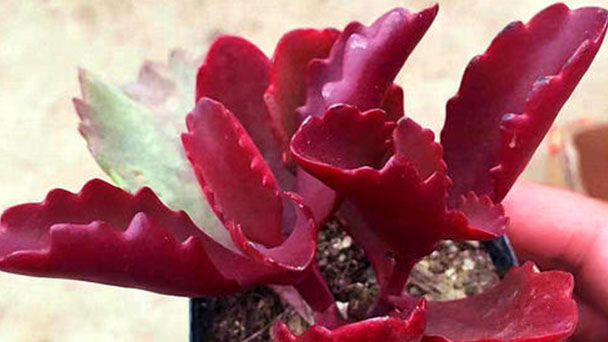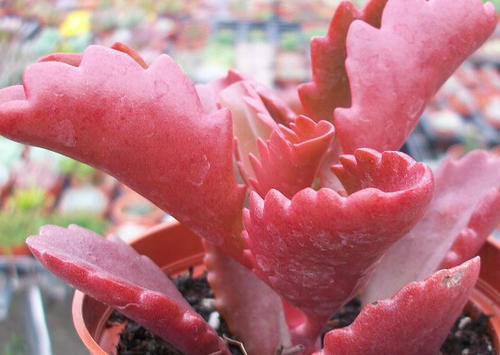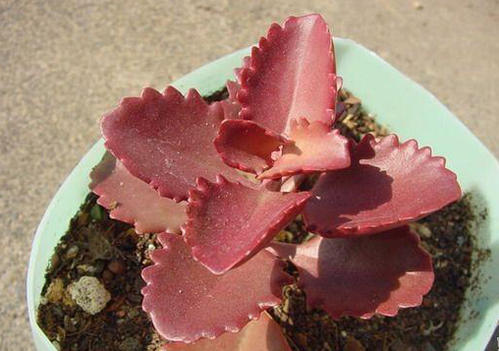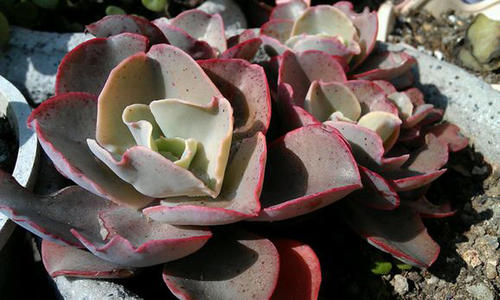Six-angled Kalanchoe profile
Written by Maggie
Feb 08 2021

Six-angled Kalanchoe, scientific name Kalanchoe sexangularis, is native to Natal, Brazil. It is grown all over the world and is often used as an ornamental potted succulent. Six-angled Kalanchoe stems are erect, purplish red;Leaves opposite, elliptic, fleshy, smooth, glossy, toothed, medium green, gradually turning purplish red or maroon under sufficient light and large temperature differences; Racemes of small yellow flowers with 4 petals in late spring to summer. Usually Six-angled Kalanchoe (Kalanchoe sexangularis) used cuttage propagation cultivation, sexual like sunshine, warm, dry, well ventilated growth environment and good drainage soil. The root system of Six-angled Kalanchoe is very strong and can be grown directly into the ground or with deep utensils. During the Spring and Autumn Period, a lot of water could be used. The propagation of Six-Anangled Kalanchoe is mainly based on cutting, which is easy to propagate.
Six-angled Kalanchoe picture

Habit characteristics of six-Anchored kalanchoe
Six-angled Kalanchoe (Kalanchoe sexangularis) is a succulent plant of the genus Angiophora in the family Angophora. It has thin and fat leaves that are resistant to heat and disease. The leaves are green in color and are relatively easy to grow. The color of the leaves is green. It's very ordinary and unattractive. The whole Six-angled Kalanchoe (Kalanchoe sexangularis) turns red when the sun is full and the temperature is different. The roots are very strong and can be grown directly into the ground or in deep pots. Flowering is in full bloom in spring. Six-Anchor likes the sun very much. The leaves are thick and sun-resistant. May be full of sunshine, almost no dormant period. Spring and autumn is a period of rapid growth. Six-angled Kalanchoe loves warm environments, tolerates drought but not cold.
Six-angled Kalanchoe growing methods
planting
Plant Six-angled Kalanchoe (Kalanchoe sexangularis) in early spring or change on the pot. Potted with leaf rot soil (or mixed carbon soil), garden soil and coarse sand mixed culture soil for pot soil, and add the right amount of decayed organic cake fertilizer as a base fertilizer.
Light and Temperature
Six-angled Kalanchoe (Kalanchoe sexangularis) is a long - day plant, appropriate extension of light is conducive to growth. Growing period should be placed in a sunny place, as far as possible to accept sunlight irradiation.
But when the summer is hot, Six-angled Kalanchoe (Kalanchoe sexangularis) should be shaded or placed under a tree in a sparse shade, avoid strong direct sunlight, and pay attention to ventilation, too wet, overheating environment plants grow poorly.Suitable growth temperature is 20-30 ℃. In winter Six-angled Kalanchoe should be placed in the indoor sunny place, room temperature to maintain about 10℃.

Watering and fertilizing
In the Six-angled Kalanchoe (Kalanchoe sexangularis) growing period appropriate watering should not be too much watering, basin soil to maintain appropriate dry, dry surface but basin water, excessive watering and fertilization easy to cause stem and leaves long and rotten leaves rotten root death. Ventilation should be strengthened in areas with high temperature and humidity in summer. Water is appropriate, but also not too much, to avoid long-term basin soil too wet, but not from the upper to the leaf spray water. Winter to control watering, basin soil to keep appropriate dry. In the Six-angled Kalanchoe growing period, it can be a small amount of fertilizer, 1-2 times a month to thin liquid fertilizer.
Six-angled Kalanchoe propagation method
1. Pick the branches
Choose the side branches or top branches of healthy disease-free In the Six-angled Kalanchoe (Kalanchoe sexangularis) growing period, cut them quickly with a knife, and leave as many leaves as possible.
2. Cutting after drying
To improve the propagation success of the In the Six-angled Kalanchoe (Kalanchoe sexangularis) growing period, the cuttings should be dried in a cool place for 3-5 days, or the cuttings should be coated with a bactericidal powder to fully heal.

Latest Updated
- Benefits of Bugleweed - 7 Science-backed Health Benefits
- Bugleweed Dangers & Side Effects - Is It Poisonous?
- How to Plant Evergreen Trees - What You Should Know
- When to Plant Evergreens - Grow Guide for Evergreen Trees
- 12 Wonderful Evergreen Shrubs for Your Garden
- 12 Popular Evergreen Plants with Pictures for Beginners
- When And How To Prune A Lilac Bush Like a Pro
- How to Grow & Care for Lilac Vine (Hardenbergia Violacea)
- Japanese Lilac Tree (Syringa Reticulata) Care & Propagation Guide
- Shumard Oak Pros and Cons - What to Know
Popular Articles
- Winter maintenance of Antirrhinum Majus
- How to Grow Terminalia Mantaly Tree
- How to Grow and Care for Crossostephium Chinense
- How to grow Antirrhinum Majus in spring
- Peristeria Elata (Dove Orchid) Profile: Info & Care Guide
- Underwatered Snake Plant (Sansevieria Trifasciata) - Signs And How To Fix
- How to Care for Brazilian Jasmine Plant (Mandevilla Sanderi)
- How to Grow & Care for Graptopetalum Purple Delight in Summer
- Rosa Chinensis (China Rose): Plant Growing & Care Tips
- How to Care for Baby Sun Rose (Aptenia Cordifolia)